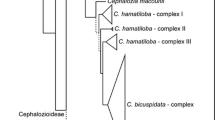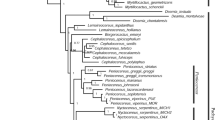Abstract
Although Echinosophora Nakai has been known as a monotypic and endemic genus of Papillionoideae of Fabaceae in Korea, it has been controversial whether it is distinct from or merged with Sophora. To resolve this matter, we conducted molecular phylogenetic analyses using nucleotide sequence data from the plastid rbcL gene and trnL (UAA) intron. Parsimony analysis, using a total of 53 taxa of the Papillionoideae (including E. koreensis [Nakai] Nakai and several species of Sophora and related genera) and using 20 taxa of Caesalpinioideae and Mimosoideae as outgroups, showed that, although the examined species of Sophora are split into two clades, E. koreensis formed a common clade with S. tomentosa (the type species of the genus) and S. flavescens. E. koreensis therefore should be treated as S. koreensis Nakai, and the generic name Echinosophora be eliminated. We also investigated the embryology of S. koreensis (=E. koreensis) and S. flavescens and found that no differences existed between them. Our molecular study, like other studies, strongly suggested that Sophora is polyphyletic. In this study we presented a summary of embryological features of the core Sophora for future critical comparison with related and unrelated taxa.




Similar content being viewed by others
References
Bremer K (1988) The limits of amino acid sequence data in angiosperm phylogenetic reconstruction. Evolution 42:795–803
Bremer K (1994) Branch support and tree stability. Cladistics 10:295–304
Chung Y, Lee S (1990) A palynotaxonomic study of the Sophora group. Korean J Plant Taxon 20:257–282
Chung Y, Lee S (1991) Studies on the wing petal morphology of the Sophora group. Korean J Plant Taxon 21:37–54
Corner EJH (1976) The Seeds of Dicotyledons, vols 1, 2. Cambridge University Press, Cambridge
Doyle JJ, Doyle JL, Ballenger JA, Dickson EE, Kajita T, Ohashi H (1997) A phylogeny of the chloroplast gene rbcL in the Leguminosae: taxonomic correlations and insights into the evolution of nodulation. Am J Bot 84:541–554
Eriksson T (2001) AutoDecay version 5.0. Bergius Foundation, Royal Swedish Academy of Sciences, Stockholm (program distributed by the author)
Felsenstein J (1985) Confidence limits on phylogenies: an approach using the bootstrap. Evolution 39:783–791
Hasebe M, Iwatsuki K (1990) Adiantum capillusveneris chloroplast DNA clone bank: as useful heterologous probes in the systematics of the leptosporangiate ferns. Am Fern J 80:20–25
Hasebe M, Omori T, Nakazawa M, Sano T, Kato M, Iwatsuki K (1994) rbcL sequences provide evidence for the evolutionary lineages of leptosporangiate ferns. Proc Natl Acad Sci USA 91:5730–5734
Kajita T, Ohashi H, Tateishi Y, Bailey CD, Doyle JJ (2001) rbcL and legume phylogeny with particular reference to Phaseoleae, Millittieae, and allies. Syst Bot 26:515–536
Kim MJ (1986) Regional distribution and karyotype of Echinosophora koreensis. MSc thesis, Kangwon National University
Lee TB (1993) Illustrated flora of Korea, 5th edn. Hyangmunsa, Seoul, p 466
Lee TB (2003) Coloured flora of Korea. Hyangmunsa, Seoul, p 586
Lee WT (1969) A discussion on Korean endemic genera plants. Korean J Plant Taxon 1:15–21
Lee WT (1996) Lineamenta florae Koreae. Academy, Seoul, p 568
Lee YN (1996) Flora of Korea. Kyohak, Seoul, p 367
Nakai T (1919) Notulae ad plantas Japoniae et Koreae XIX. Bot Mag (Tokyo) 33:1–11
Nakai T (1923) Genera nova Rhamnacearum et Leguminosarum ex Asia Orientali. Bot Mag (Tokyo) 37:29–34
Pennington RT, Lavin M, Ireland H, Klitgaard B, Preston J, Hu J-M (2001) Phylogenetic relationships of basal Papillionoid legumes based upon sequences of the chloroplast trnL intron. Syst Bot 26:537–556
Polhill RM (1981) Sophoreae. In: Polhill RM, Raven PH (eds) Advances in legume systematics, part 1. Royal Botanical Gardens, Kew, pp 213–230
Schmid R (1986) On Cornerian and other terminology of angiospermous and gymnospermous seed coats: historical perspective and terminological recommendations. Taxon 35:476–491
Setoguchi H, Ohba H (1995) Phylogenetic relationships in Crossostylis (Rhizophoraceae) inferred from restriction site variation of chloroplast DNA. J Plant Res 108:87–92
Sousa MS, Rudd VE (1993) Revision del genero Styphnolobium (Leguminosae: Papillionoideae: Sophoreae) Ann Mo Bot Gard 80:270–283
Swofford DL (2000) PAUP* (beta), version 4.0b10. Sinauer, Sunderland, Massachusetts, USA
Taberlet P, Gielly L, Pautou G, Bouvet J (1991) Universal primers for amplification of three non-coding regions of chloroplast DNA. Plant Mol Biol 17:1105–1109
Tobe H (1989) The embryology of angiosperms: its broad application to the systematic and evolutionary study. Bot Mag (Tokyo) 102:352–367
Tobe H, Raven PH (1984) The number of cells in the pollen of Melastomataceae (Myrtales). Bot Mag (Tokyo) 97:131–137
Yakovlev GP (1972) A contribution to the system of the order Fabales Nakai (Leguminales Jones). Bot Zhurn 57:585–595
Acknowledgement
This study was supported by Grants-in-Aid (Nos. 3001139-1-1 and 2001338) from Scientific Foundation of Kangwon National University to Kweon Heo.
Author information
Authors and Affiliations
Corresponding author
Appendix 1
Appendix 1
Taxa and GenBank accession numbers are listed in Table 2.
Rights and permissions
About this article
Cite this article
Lee, W.K., Tokuoka, T. & Heo, K. Molecular evidence for the inclusion of the Korean endemic genus “Echinosophora” in Sophora (Fabaceae), and embryological features of the genus. J Plant Res 117, 209–219 (2004). https://doi.org/10.1007/s10265-004-0150-x
Received:
Accepted:
Published:
Issue Date:
DOI: https://doi.org/10.1007/s10265-004-0150-x




